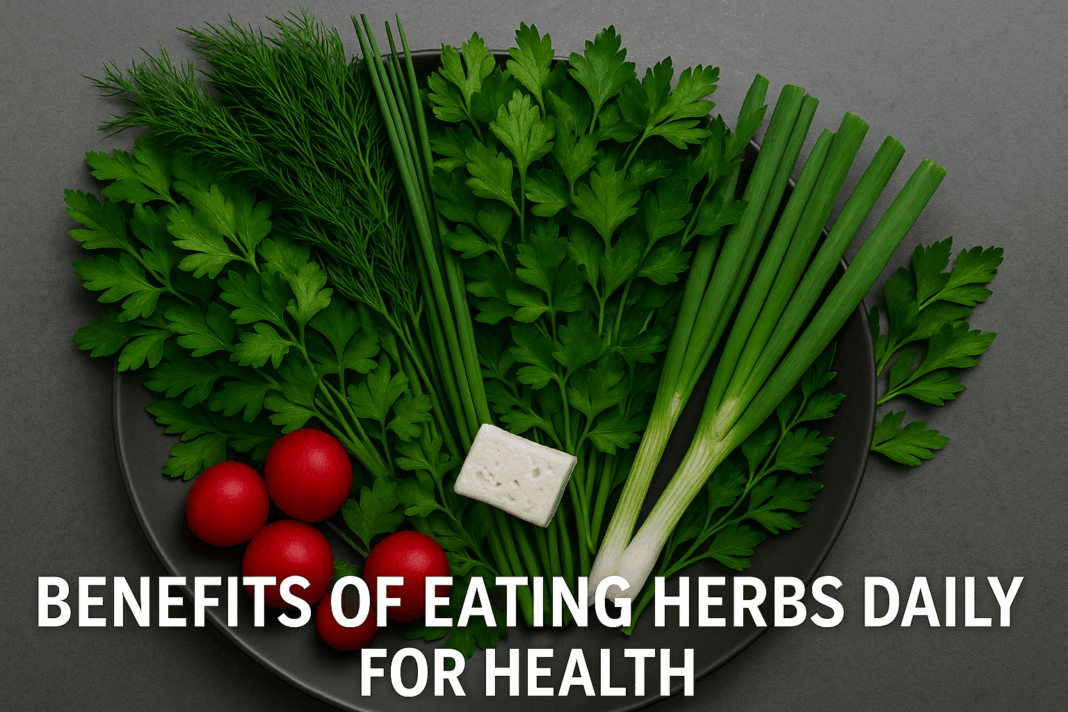Exercise Daily _ Benefits of Eating Herbs Daily for Health
Are herbs just garnishes on your plate? Think again. Across the world, herbs are the unsung heroes of health, longevity, and flavor — and it’s time we start treating them as such.
Why Culinary Cultures That Eat Herbs Daily Are Healthier
From the lush mountains of Iran to the kitchens of Jewish grandmothers, herbs are not just condiments — they are a cornerstone of daily life. Many cultures incorporate fresh herbs into every meal, not for garnish, but for healing, digestion, and immunity.
Global Cultures That Treat Herbs Like Medicine
Herbs are sacred in ancient systems like Ayurveda, Traditional Chinese Medicine (TCM), and Kampo (Japanese herbal medicine). In these traditions, every herb has a purpose — balancing the body, healing disease, and enhancing longevity.
In Persian cuisine, fresh herbs — called “sabzi khordan” — are a daily side dish. You’ll see heaps of mint, tarragon, chives, parsley, and basil served with nearly every meal. These herbs are believed to cool the body, cleanse the blood, and aid digestion. Persian tradition doesn’t just sprinkle herbs — it eats them by the handful.
Jewish traditions, especially during Passover, highlight the importance of herbs like maror (bitter herbs, often horseradish) to symbolize purification and remembrance. These customs also reflect herbs’ role in supporting digestion and warding off illness during seasonal transitions.
In Latin American cultures, herbs like oregano, cilantro, epazote, and culantro are essential — not optional. They’re stirred into soups, sprinkled over grilled meats, and blended into healing teas. In fact, many abuelas (grandmothers) serve as unofficial herbalists in their families.
India: The Science of Ayurveda and Spices
India’s 5,000-year-old Ayurveda system prescribes herbs for everything from digestion to joint pain. Turmeric, cumin, coriander, fenugreek, fennel, tulsi (holy basil), and ajwain are not just flavorings — they’re preventive medicine. Indian meals always include digestive herbs like cumin seeds in dal, coriander in chutneys, and fennel seeds chewed after meals to aid digestion and freshen breath.
Popular Ayurvedic herb blends include:
- Trikatu: A mix of black pepper, long pepper, and dried ginger for metabolism
- Chyawanprash: A herbal jam containing over 30 herbs to boost immunity
China: Herbal Tonics in Daily Life
In Traditional Chinese Medicine (TCM), herbs are carefully classified by energy (hot/cold), flavor (bitter/sweet/sour), and body organ target. Common herbs like ginger, ginseng, astragalus, and goji berries are consumed daily in teas and broths to boost qi (life force) and support the liver, kidneys, and digestion.
Even meals are structured for medicinal effect — for example, “Herbal Chicken Soup” with ginseng, red dates, and angelica is used to prevent fatigue and enhance circulation.
Japan: Kampo and Culinary Elegance
In Japanese Kampo medicine, herbs like shiso (perilla leaf), yuzu peel, wasabi, and ginger are essential. Shiso is antiseptic and aids digestion; wasabi fights bacteria in raw fish; and pickled ginger refreshes the palate and supports gut health.
Japanese cuisine subtly integrates herbs — not to overpower, but to align the body’s balance. Kombu and shiitake mushrooms, though not “herbs” per se, are considered medicinal foods for umami and immune strength.
Korea: Fermented Herbs and Gut Healing
Korean meals are famous for including dozens of side dishes (banchan), many of which are herb-rich. Perilla leaves, garlic chives, and sesame leaves are served fresh or pickled. Kimchi — made with garlic, ginger, and gochugaru (Korean red pepper) — isn’t just fermented cabbage; it’s a probiotic powerhouse enhanced by healing herbs.
Many Koreans also consume ginseng tonics and teas, especially during seasonal changes, to support stamina and prevent respiratory illness.
Other Traditional Uses
- Ethiopian cuisine uses **besobela (sacred basil)** and **korarima** (Ethiopian cardamom) in spice blends like berbere.
- Thai cuisine is rich in lemongrass, kaffir lime leaves, Thai basil — all antibacterial and anti-inflammatory.
- Vietnamese dishes always come with fresh herb baskets: mint, Thai basil, and coriander — eaten raw alongside noodles and grilled meats.
Across the world, these cultures know something modern diets have forgotten: when you eat herbs daily, you’re not just adding flavor — you’re fortifying your health.
Compare that to the standard American dinner: meat, a starch, and perhaps a sad sprig of parsley. It’s no wonder the U.S. ranks among the top nations for preventable chronic illness.
Herbs Are Food — and Medicine
Before pharmacies, there were gardens. Herbs like thyme, basil, rosemary, oregano, and sage have been used for centuries as natural remedies for infection, inflammation, and indigestion.
What makes herbs so powerful?
- Polyphenols: Found in herbs like rosemary and oregano, these compounds fight oxidative stress and aging.
- Antibacterial oils: Basil, thyme, and mint contain oils that kill bad bacteria in the gut and mouth.
- Chlorophyll: Found in all green herbs — helps detoxify the body and oxygenate the blood.
Think of mixed herbs as your natural pharmacist. When used together — like in za’atar, gremolata, or chimichurri — their synergy boosts absorption of nutrients and prevents bloating, fatigue, and infections.
Herbs as Natural Digestive Enzymes
Ever wonder why Italian dishes often end with fennel or parsley? Or why Indian chutneys contain mint and cilantro? It’s not just for taste. These herbs help your digestive system process heavy meals.
✔️ Parsley: Helps reduce bloating and supports kidney detox
✔️ Mint: Calms the stomach and soothes indigestion
✔️ Fennel: Reduces gas and helps break down proteins
✔️ Oregano: Antibacterial and supports healthy gut flora
Americans Rarely Eat Herbs — And It Shows
Despite global traditions, Americans largely ignore herbs in their daily diet. In fact, most only consume herbs in sauces, seasoning packets, or dried form — which loses up to 70% of medicinal value. Fresh herbs are often seen as optional, too expensive, or “not filling.” But that mindset may be costing us our health.
Latin cultures, by contrast, not only eat herbs regularly but also pass down herbal remedies across generations. In Mexican households, herbs like epazote are added to beans to prevent gas, while teas made from chamomile or cinnamon are used for calming the gut.
“Herbs Are Too Expensive” – A Myth
One bunch of parsley costs less than $1.50 and lasts an entire week. Compare that to a bottle of Tums or multivitamins. Herbs are the most nutrient-dense, affordable ingredient you can buy. Better yet, they can grow in a small pot by your window — mint, basil, and thyme don’t even need a yard.
Easy Ways to Eat Herbs Every Day
1. Salad Herb Blend (Mediterranean Style)
Ingredients: Parsley, dill, mint, cilantro, chopped red onion, cucumber, lemon juice, olive oil, sea salt
Instructions: Mix all chopped herbs and veggies. Dress with lemon and oil. Serve with grilled meat or chickpeas.
2. Persian “Sabzi Khordan” Herb Platter
Ingredients: Fresh mint, tarragon, chives, basil, radish, feta cheese, walnuts
Instructions: Rinse and serve herbs whole alongside bread, feta, and nuts for a digestive boost.
3. Digestive Mint & Ginger Tea
Ingredients: Fresh mint, grated ginger, hot water, lemon
Instructions: Steep herbs in hot water for 5–7 minutes. Drink after meals to aid digestion and reduce bloating.
4. Chimichurri Sauce (Latin Remedy-Style)
Ingredients: Parsley, oregano, garlic, olive oil, vinegar, red pepper flakes
Instructions: Blend all ingredients into a thick sauce. Use as a marinade or dip. Antibacterial + immune support!
Remedies & Preventative Use
- Prevent infection: Thyme, oregano, and sage are natural antibacterials. Use in soups, teas, or as garnish.
- Gut health: Mint, parsley, and dill help ease cramping and bloating after meals.
- Respiratory relief: Basil and thyme open airways and soothe coughs.
Scientific References
Herbs aren’t just folk medicine — they’re backed by science:
- NCBI: Medicinal Plants and Gut Health
- Oregano’s Antimicrobial Properties – NCBI
- Herbs and Polyphenols for Anti-Aging
Final Thoughts: Herbs Should Be the Base of Every Meal
We’ve been trained to focus on proteins and carbs, but it’s time to flip the plate. Start with herbs. Let them be your appetizer, your side dish, your base — not your afterthought. Cultures that live the longest (like the Mediterranean and Middle Eastern regions) use herbs in almost every meal, every day.
So the next time you’re meal prepping, remember: vegetables and protein are great, but herbs are elite. They’re food. They’re medicine. They’re cheap. And they’re your best health insurance.
Eat daily, sleep daily, exercise daily.
These insights are for informational purposes only. Consult your doctor and do your own research before use.




